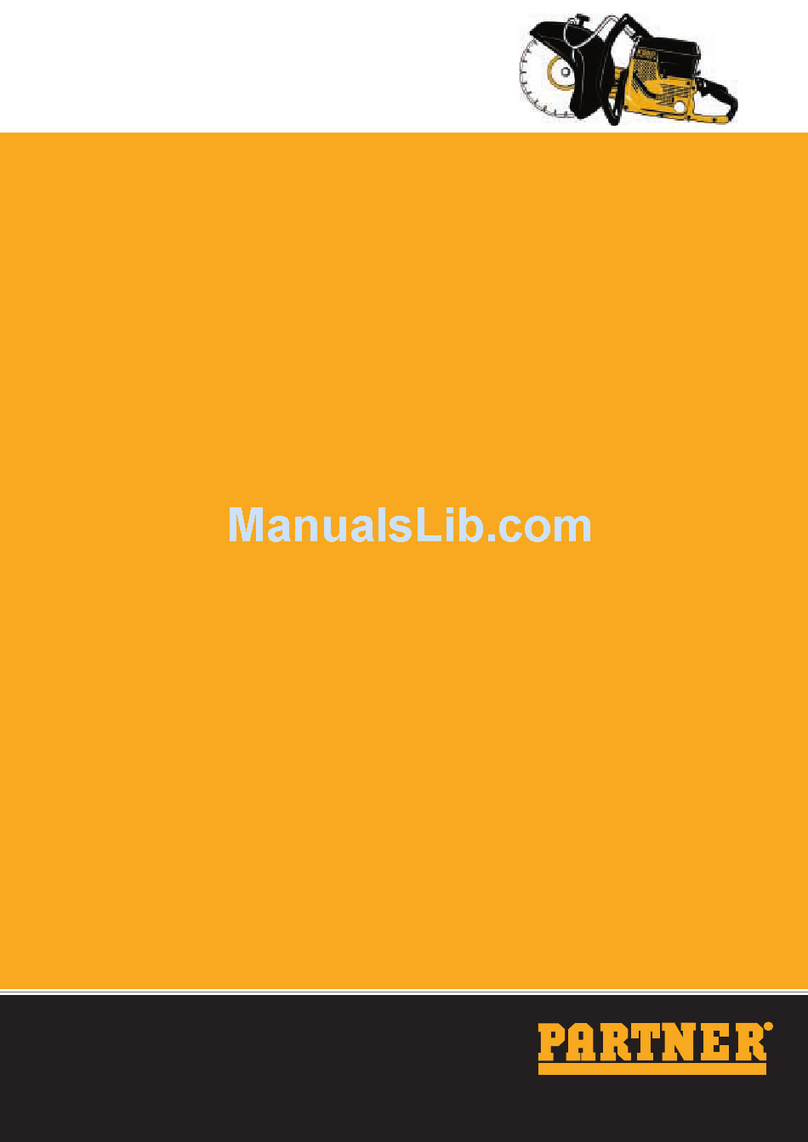English –7
Fuel safety
(Filling/Fuel mixture/Storage)
WARNING! Exercise great care when handling
fuel. Bear in mind the risk of fire, explosions
and inhaling fumes.
•Never fill the machine while
the engine is running.
•Provide good ventilation
when filling or mixing fuel
(gasoline and 2-stroke oil).
•Move the machine at least 3
m from the filling position
before starting.
•Never start the machine:
a) If you have spilt fuel
on it. Wipe up all
spillage.
b) If you have spilt fuel
on yourself or your
clothes. Change your
clothes.
c) If there is a fuel leak.
Make regular checks for
leakage from the fuel
cap and the fuel supply
pipes.
•Store the power cutter and fuel so that any leakage or fumes
do not risk coming into contact with sparks or naked flames.
For example, electric machines, electric motors, electrical
switches/power switches, heaters or the like.
•When storing fuel, approved containers intended for this
purpose must be used.
•When storing the power cutter for long periods the fuel tank
must be emptied. Contact your local fuel station to find out
how to dispose of excess fuel.
•Use a Partner fuel can with an anti-spill device.
SAFETY INSTRUCTIONS
!
!WARNING! Use a Partner fuel can with an
anti-spill device. Fuel and fuel fumes are
highly flammable. Think of the risks of fire,
explosion and breathing in fumes. Stop the
engine before refuelling. Do not overfill with
fuel. Mop up any spills on the ground or the
machine. If you spill fuel on yourself or your
clothes, change your clothes. Move the
machine at least 3 metres from the refuelling
site before starting.
GENERAL WORKING INSTRUCTIONS
This section takes up the basic safety precautions for working
with the power cutter. Follow these general working instructions,
but never use a machine without the possibility of calling for
help in the event of an accident.
Basic safety precautions
IMPORTANT INFORMATION! Never work with a power
cutter that is defective or incorrectly adjusted. Do not
work with a power cutter that is incomplete or where
assembly has not been carried out in a satisfactory
manner. Check that the cutting blade stops rotating
when the throttle is released. If you encounter a situation
where you are uncertain how to proceed you should ask
an expert.
Avoid all usage which you consider to be beyond your
capability.
•Check that no one is in the immediate vicinity when the
machine is started or while working with the machine to
ensure that people, animals or other things cannot affect your
control of the power cutter.
•Avoid usage in unfavourable weather conditions, for example,
thick fog, heavy rain, strong winds or extreme cold, etc. To
work in bad weather conditions is tiring and can create
dangerous circumstances, e.g. slippery surfaces.
•Never start to work with the power cutter before the working
area is clear and you have a firm foothold. Look out for any
obstacles with unexpected movement. Ensure when cutting
that no material can become loose and fall, causing operating
injury.Take great care when working on sloping ground.
•Make sure clothing and parts of the body do not come into
contact with the cutting blade when the engine is started.
•Maintain a safe distance from the cutting blade when the
engine is running.
•The blade guard should always be fitted when the engine is
running.
•Ensure that the working area is sufficiently illuminated to
create a safe working environment.
•Do not move the power cutter with the blade rotating.
•Make sure that no pipes or electrical cables are routed in the
area to be cut.
WARNING! A safe distance from the power
cutter is 15 metres. You are responsible that
animals and onlookers are not in the working
area. Do not start to work with the power
cutter before the working area is clear and
you have a firm foothold.
•Start cutting with the engine at full throttle.
•Always hold the power cutter firmly, with both hands. Hold
the machine so that the thumb and fingers grip around the
handle.
Cutting
Only use the machine in areas with good
ventilation. Neglect can result in serious
injury or death. Carbon monoxide in the
exhaust fumes causes suffocation.
!
!
Min 3 m (10ft)




































